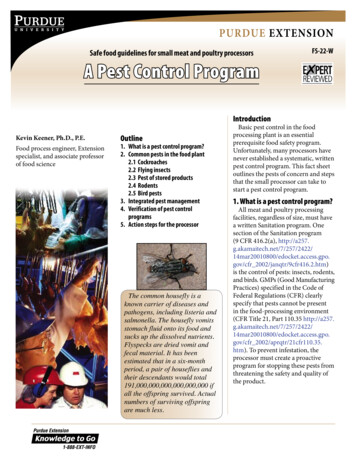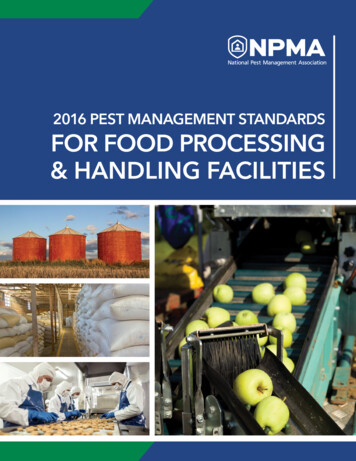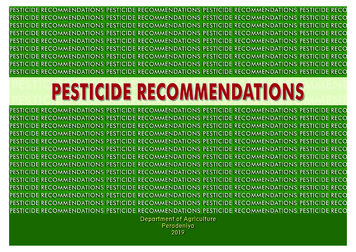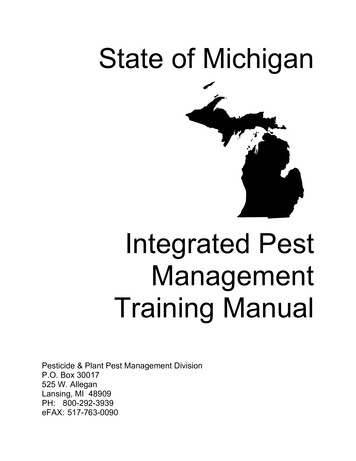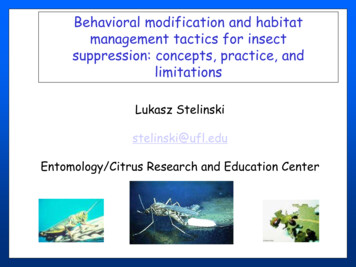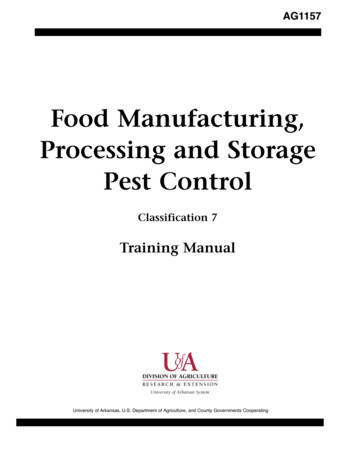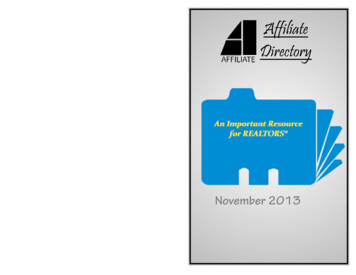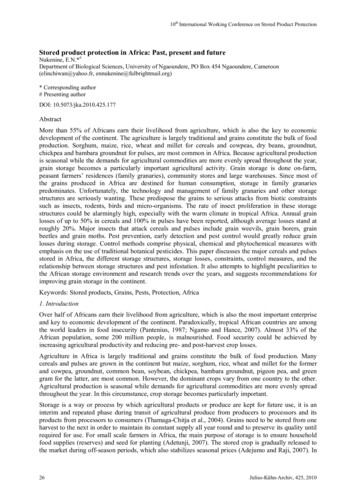
Transcription
INTEGRATED PESTMANAGEMENT PLANOCTOBER 2017MARINE CORPS BASE CAMP PENDLETON,CAPrepared byNaval Facilities Engineering Command Southwest,San Diego, CA
DOCUMENT IDENTIFICATIONDocument Title:Integrated Pest Management PlanSite Name/Location:Marine Corps Base Camp Pendleton, CaliforniaWork Order No.:1171820Document Coverage:This document is the plan for conducting integrated pestmanagement at Marine Corps Base Camp Pendleton, CaliforniaOrganization Title:Address:Marine Corps BaseCamp Pendleton, CANavy Project Manager:Address:Michael Medina, M.S.Naval Facilities Engineering Command SouthwestCode EV51.MM1220 Pacific HighwaySan Diego, CA 92132-5190
ii
This page left intentionally blank.iii
iv
This page left intentionally blank.v
INTEGRATED PEST MANAGEMENT PLAN REVIEW RECORDYearIntegrated Pest ManagementCoordinator (Annual)Pest Management ConsultantOn-Site Review (as arranged)1516On-site program review1718IPMP rewrite19vi
This page left intentionally blank.vii
TABLE OF CONTENTSTABLE OF CONTENTS.viiiTABLES AND FIGURES . ixAPPENDICES . ixABBREVIATIONS . xExecutive Summary . xiii1 Introduction . 11.1Background . 11.2The Integrated Pest Management Plan . 11.3Pest Management Program Overview . 41.4Regulatory Compliance. 61.5Program Requirements . 91.6References . 92 Administration . 152.1Roles and Responsibilities . 152.2Staffing and Facilities . 192.3Training, Certification and Licensing . 202.4Pesticide Approval . 232.5Records and Reporting . 242.6Government Contracts . 242.7Private Housing Leases . 262.8Other Leases . 282.9References . 283 Operations . 293.1Integrated Pest Management . 293.2Pests on MCBCP . 303.3Pest Management Operations . 323.4Pesticide Management . 373.5References . 404 Health and Safety . 434.1Pesticide Applicator Safety . 434.2Public Safety . 464.3Pest Control Accidents. 484.4References . 495 Environmental Considerations . 515.1Environmental Management System (EMS) for Pest Management . 515.2Environmental Considerations on the Pesticide Label . 525.3Managing Environmental Impact . 525.4References . 576 Emergency Pest Management . 596.1Public Health Emergencies . 596.2Agricultural Emergencies . 596.3Emergency Pest Management Resources . 606.4References . 607 Program Resources . 617.1Agencies . 617.2Publications . 62viii
TABLES AND FIGURESTable 1: Pest Management Program Review Schedule . 4Table 2: MCB Camp Pendleton DoD and Commercial Pest Management Service Providers . 4Table 3: Pest Management Program Administration Requirements . 11Table 4: Pest Management Program Operations Requirements. 13Table 5: Summary of MCBCP Pest Management Licensing and Recertification Training Requirements . 23Table 6: Pesticide use (in pounds of active ingredient, PAI) on the MCBCP, Oct 2011 – Sep 2012 . 37Figure 1. Location of MCB Camp Pendleton. . 1Figure 2. MCB Camp Pendleton provides training facilities for Marines and Sailors preparing to deploy.USMC Photo by Lance Cpl. Trevon S. Peracca. . 6Figure 1. MCCS Semper Fit maintains turf on recreational fields. USMC Photo. . 18Figure 4. Pests / pest groups controlled on MCB Camp Pendleton from Oct 2011-Sep 2012. (Total pestmanagement service records 1,342) . 31Figure 5. An ultra-low volume (ULV) fogger is used for applying insecticides for adult mosquito control.Photo by Mr. M. Medina. . 33Figure 6. Units and commands on the installation can purchase pesticides and pest control items from theConsolidated Material and SVC Center for self-help use. Photo by Mr. C. Martin. . 35Figure 7. Pesticide containers must be secured in vehicles to prevent spills. Photo by Mr. M. Medina. . 39Figure 8. MCCS uses contracted commercial services to perform pest control at recreational areas onMCB Camp Pendleton. Photo by Mr. M. Medina. . m ReviewPesticidesEquipmentContractsPest Management quito Managementix
ABBREVIATIONS3rd PAEPCRAEPSESESA3rd Marine Aircraft WingApplied BiologyArmed Forces Pest Management BoardAnimal and Plant Health Inspection Service(USDA)Application of Pesticides PlanBird Aircraft Strike HazardBranch Health ClinicBase OrderBase Operation SupportBase Operation Support ContractNavy Bureau of Medicine and SurgeryClean Air ActCounty Agricultural CommissionerCalifornia Environmental Protection AgencyCalifornia Department of TransportationCalifornia Code of RegulationsCenters for Disease Control and PreventionCalifornia Department of Food andAgricultureCalifornia Department of Public HealthCode of Federal RegulationsCommanding GeneralChief of Naval OperationsCommander, Pacific FleetContracting Officer RepresentativeClean Water ActContractor Work PlanDefense Commissary AgencyCalifornia Department of Fish and WildlifeDepartment HeadDivision OfficerDepartment of DefenseDepartment of the NavyDepartment of TransportationCalifornia Department of PesticideRegulationDisease Vector Ecology ProfileExternal AssessmentEmulsifiable ConcentrateEnvironmental Compliance EvaluationEnvironmental HealthEnvironmental Health OfficerEnvironmental Impact StatementEnvironmental Management SystemExecutive OrderU.S. Environmental Protection AgencyEmergency Planning and Community Rightto Know ActEnvironmental Protection SpecialistEnvironmental SecurityEndangered Species Actx
ETEVDCPFAPFDAFIFRAFMDFMFFQPAFSCHMMSHQMCHSWAI NBNDSLNECENEPMU FIVENHNMCINMCPHCNMCSDNOINOPRSNOSCEndangered and threatenedEmergency Vector-borne Disease ControlPlanFunctional Assessment PlanU.S. Food and Drug AdministrationFederal Insecticide, Fungicide, andRodenticide ActFacilities Maintenance DepartmentFleet Marine ForceFood Quality Protection ActFacility Support ContractHazardous Materials Management SystemHeadquarters Marine CorpsHazardous and Solid Waste ActFirst Marine Expeditionary ForceInternal Assessment PlanIntegrated Contingency PlanIntegrated Cultural Resources ManagementPlanIntegrated Environmental Compliance PlanInstallation Environmental Program ManagerIndustrial Hygiene OfficerIntegrated Natural Resources ManagementPlanIntegrated Pest ManagementIntegrated Pest Management PlanContracting OfficerMosquito Abatement DistrictMarine Corps Base Camp PendletonMarine Corps Communications ElectronicSchoolMarine Corps Community ServicesMarine Corps InstallationsMarine Corps OrderMarine Corps ExchangeMilitary Family HousingMemorandum of AgreementMemorandum of UnderstandingMedical Service CorpsMaterial Safety Data SheetMedical Treatment FacilityNon-appropriated fund instrumentalityNaval Facilities Engineering CommandNavy Occupational Safety and HealthNaval BaseNavy Drug Screening LaboratoryNavy Entomology Center of ExcellenceNavy Environmental and PreventiveMedicine Unit FIVE, San Diego, CANaval HospitalNavy and Marine Corps IntranetNavy and Marine Corps Public Health CenterNaval Medical Center San DiegoNotice of IntentNAVFAC Online Pesticide Reporting SystemNavy Operational Support Centerxi
TOCTSCAULVUSAUSDAUSFSUSFWSUSMCUSNUSPHSNational Pollutant Discharge EliminationSystemOfficer in ChargeChief of Naval Operations InstructionOperational Risk ManagementOccupational Safety and Health AgencyPollution PreventionPrivate Applicator CertificationPesticide Application PlanPesticide authorized use listPest control operatorPublic Health DepartmentPest Management ConsultantProvost Marshal Office (Security)Pest Management Performance AssessmentRepresentative (formerly QAE)Preventive Medicine RepresentativePest Management Service ProviderPreventive Medicine TechnicianPoint of contactPollution Prevention ActPersonal protective equipmentPartner Pest Management PlanPublic, Private VenturePublic WorksQualified Applicator CertificateQualified Applicator LicenseResidential Communities InitiativeResource Conservation and Recovery ActResident Officer in Charge of ConstructionResidual toxicityRange Training AreaRestricted use pesticideSpecial AreaSecretary of the Navy InstructionStandard Operating ProcedureSenior Performance AssessmentRepresentativeStructural Pest Control BoardSpill Prevention, Control andCountermeasure PlanStation OrderStormwater Discharge Management PlanStormwater Pollution Prevention PlanTechnical GuideTriCare Outpatient ClinicToxic Substances Control ActUltra Low VolumeUnited States ArmyU.S. Department of AgricultureU.S. Forest ServiceU.S. Fish and Wildlife ServiceUnited States Marine CorpsUnited States NavyU.S. Public Health Servicexii
VAVCDWPXODepartment of Veteran’s AffairsVector Control DistrictWettable PowderExecutive Officerxiii
Marine Corps Base Camp PendletonIntegrated Pest Management PlanMarch 2014Executive SummaryThe Integrated Pest Management Plan (IPMP) is a comprehensive, long-range document that capturesall the pest management and pesticide-related activities conducted on the Marine Corps Base CampPendleton (MCBCP) property. Pest management activities on the MCBCP provide Force HealthProtection, maintain facilities, protect environmental resources, and improve personnel quality of life toensure that MCBCP accomplishes its mission of supporting the I Marine Expeditionary Force and itssubordinate and supporting commands. The pest management program includes pest control andgrounds maintenance for administrative and industrial facilities, lessee pest control, and natural resourcesprotection. This plan adds value by developing compliance systems and streamlining operationsinvolving the use of pesticides including applications, storage, reporting, and archiving records, all ofwhich are tightly regulated by the Federal Insecticide, Fungicide, and Rodenticide Act (FIFRA), state andlocal laws, Department of Defense (DoD), and Department of Navy (DoN) regulations. As a planningdocument, the IPMP is also a vital component of effective integrated pest management (IPM) andconforms to the installation’s Environmental Management System (EMS) and environmental policy.This Plan is the rewrite of the IPMP that was written in 2005. The Naval Facilities Engineering CommandSouthwest (NAVFAC Southwest) Applied Biology (AB) Program, San Diego, California, prepared this planfrom September 2012 – February 2013. Significant changes to the installation that have required thisrewrite include the privatization of military family housing, changes to pest management service providers,use of an online pest management reporting system, implementation of a Clean Water Act permit forpesticide applications to water, regulatory updates, support agreement changes, sources of supply forprocurement and changes to the pest control and grounds maintenance contracts. Added to the plan isgreater detail of pests being controlled and pesticide use. This document provides comprehensiveinformation on the installation’s pest and pesticide management program for installation staff and internaland external compliance auditors. It incorporates specific pest management practices and local, state,federal and DoD regulations. The Plan conforms to the requirements of DoD Instruction 4150.07 andMCO P5090.2A.xiii
Marine Corps Base Camp PendletonIntegrated Pest Management PlanMarch 2014This page left intentionally blank.xiv
Marine Corps Base Camp PendletonIntegrated Pest Management Plan1March 2014Introduction1.1Background1.1.1MissionMarine Corps Installations West (MCIWEST) commands and controls assigned Marine CorpsInstallations in order to support the operating forces, tenant commands, military personnel andfamilies. Marine Corps Base Camp Pendleton (MCBCP) operates a training base that promotesthe combat readiness of theoperating forces and the missionsof other tenant commands byproviding training venues, facilities,services and support in order to beresponsive to the needs ofMarines, Sailors and their Families.1.1.2Location and FacilitiesMCB Camp Pendleton, located innorthern San Diego County,California, occupies approximately125,000 acres of mostly naturalareas and 17 miles of coastlinebordering the Pacific Ocean.Figure 1. Location of MCB Camp Pendleton.Camp Pendleton is situatedbetween two major metropolitanareas: Los Angeles, 82 miles to the north, and San Diego, 38 miles to the south. Nearbycommunities include Oceanside to the south, Fallbrook to the east and San Clemente to thenorthwest. Camp Pendleton shares approximately 8 miles of its northern border with theCleveland National Forest and its eastern border with the Naval Weapons Station Seal BeachDetachment (NWSSB Det) Fallbrook. Aside from the undeveloped natural areas of NWSSB DetFallbrook, surrounding land use includes urban development, rural residential development, wildlands and active farms and ranches.Scattered throughout the base are cantonment and housing areas that contain over 2,800buildings or other structures and occupies 9,400 acres. These areas contain and are generallysurrounded by undeveloped natural areas. Much of the center of the base (approximately 32,000acres) is impact areas that are used for live firing of ordnance. Several areas along the coast areused for amphibious landing exercises. Two recreational areas, Del Mar beach in the south, andSan Onofre beach in the north, are also located on the coast.Some areas of the base are leased to outside agencies. A section of the north coast is leased toSouthern California Edison which operates the San Onofre Nuclear Generating Station while anadjacent area is leased to the California State Parks for San Onofre State Park and San MateoState Park. The California Transportation Department operates an easement through which USInterstate 5 borders the western edge of the Base.1.2The Integrated Pest Management Plan1.2.1ScopeThe MCBCP IPMP is a long-range, comprehensive planning, and operational document thatestablishes the procedures for conducting a safe, effective, and environmentally sound integratedpest management program. This IPMP covers all pest management and pesticide-relatedactivities conducted by DoD personnel and commercial pest management service providers1
Marine Corps Base Camp PendletonIntegrated Pest Management PlanMarch 2014(PMSP) on MCBCP land including housing lessees and tenant commands. The Plan does notcover MCAS Camp Pendleton or leased lands other than Housing.1.2.2Implementation AuthorityDoDINST 4150.07 and MCO P5090.2A, Chapter 14 require all Marine Corps activities thatconduct pest management operations to have an IPMP. Pest management programs at MarineCorps activities shall be conducted under an IPMP in accordance with DoDINST 4150.07 andMCO P5090.2A. NH Camp Pendleton performs pest management related activities inaccordance with OPNAVINST 6250.4C in addition to the requirements of the previous directives.1.2.3DoD Measures of MeritThis Plan provides the framework for the MCBCP to meet the DoD’s annual goals or measures ofmerit (MoM). Per DoDI 4150.07, the MoMs are:Goal 1. 100% of DoD installations will have current pest management plans. The MCBCP helpsmeet this goal by the implementation (by Commanding Officer signature) of this Plan.Goal 2. Maintain the 55% pesticide use reduction achieved from 1993-2003 (in pounds of activeingredient). The MCBCP provides data for this MoM through the reporting requirement(Section 2.6.2)Goal 3. 100% of all DoD installation pesticide applicators will be appropriately certified. TheMCBCP ensures proper certification of all applicators through regular verifications andmaintains a list of certifications in Appendix K of this Plan. See section 2.4 for trainingand certification requirements.1.2.4Using the IPMPThe IPMP provides a comprehensive overview of pest management and pesticide relatedoperations on MCBCP. It can be used as a reference by all installation personnel and can beprovided to external regulators. The IPMP is divided into the core plan and appendices. ThePlan is provided in a hard copy and electronic form.1.2.4.1 CoreChapter 1. Introduction: Provides an overview of the IPMP and the installation pestmanagement program. Federal and State regulatory compliance is described toprovide the source of the compliance requirements in the rest of the Plan.Chapter 2. Administration: Describes the organization of the pest management programand identifies the staffing and their roles and responsibilities. This section alsolists and describes the primary DoD requirements for DoD and contract PMSPs.Chapter 3. Operations: Provides descriptions of pests, integrated pest managementpractices, and the management of pesticides. Compliance requirements for allthe pesticide management practices are provided.Chapter 4. Health and Safety: Describes the potential health hazards for the pesticideapplicators as well as the public due to pest management operations on theinstallation. Hazard abatement practices and medical emergencies are alsodiscussed.Chapter 5. Environmental Considerations: Describes the pest management programwithin the framework of EMS including a description of hazards to theenvironment of chemical and non-chemical practices.Chapter 6. Emergency Pest Management: Provides a description of and resources in theevent of public health or agricultural pest management emergencies.Chapter 7. Resources: A list of DoN and local resources for pest management issues.Each chapter contains a reference section with publications and websites used to prepare thePlan and others that provide additional information. Where appropriate references are citedin the text of the chapter and indicated by the reference number in parentheses at the end ofthe sentence. Most of the publications can be found on the CD that is included with theIPMP.2
Marine Corps Base Camp PendletonIntegrated Pest Management PlanMarch 20141.2.4.2 AppendicesThe contents of the appendices are designed to be modified depending on the needs of the pestmanagement service provider (PMSP) or stakeholder that possesses the IPMP. Some of thecontents are included in the binder while others are in electronic form on the CD.Appendix A. Includes space for installation maps.Appendix B. Contains a list of definitions for words and terms used in the IPMP.Appendix C. Provides a list of federal laws, state regulations, DoD instructions, andinstallation instructions / orders related to pest management. Copies of DoDI4150.07 and MCO 5090.2A are included. Other regulatory and policydocuments related to the installation program are also included.Appendix D. Provides space for copies of pest management program reviews andcompliance inspection reports. DoD and state compliance checklists and IPMPupdate forms are also included.Appendix E. The approved pesticides lists for each of the installation’s PMSPs are includedin this appendix. Pesticide labels and MSDSs can be added to this appendix.Appendix F. A list of equipment used by PMSPs is included. This appendix can be used forequipment maintenance records, manuals, or other related documents.Appendix G. Use this appendix to keep contract information including contract specificationsand the contractors’ work plans.Appendix H. Integrated Pest Management Project Summaries for each of the pests or pestgroups found on the installation are included here. Add partner PMPs and/orany other activity pest management plans or procedures.Appendix I. Contains installation-specific EMS documents. Installation environmental plansor excerpts of plans that pertain to pesticides and pest management areincluded as well.Appendix J. Contains the installation Emergency Vector-borne Disease Control Plan(EVDCB) and other documents related to vector surveillance and control. If theinstallation has a pest control shop, reports of industrial hygiene surveys mayalso be included.Appendix K. Space is provided for applicator licenses and certifications and training records.Appendix L. An installation point of contact sheet is provided. Additional resources can beadded.Appendix M. This appendix includes information on mosquito management including anIntegrated Mosquito Management Plan and related references.1.2.4.3 CD-ROMElectronic versions of the Plan are provided. These include the core plan and all appendices aswell as the full contents of the NAVFAC Southwest Pest Management Resource CD-ROM whichincludes downloadable forms and templates, pest management technical guides and handbooks,DoD directives, and pest management website links. Only the IPM Coordinator receives the“Master” CD-ROM that contains a Microsoft Word version of the core plan. PMSPs willreceive the “Provider” version that contains the core plan in Adobe Acrobat format. Bothversions will contain forms and templates in their original format.1.2.5Plan MaintenanceThe IPMP must be reviewed and updated annually (DoDI 4150.07). The IPM Coordinator isresponsible for coordinating with PMSPs and stakeholders to review and update the plan. Theschedule for Plan and Program review is:3
Marine Corps Base Camp PendletonIntegrated Pest Management PlanMarch 2014Table 1: Pest Management Program Review ScheduleMarch2015Annual internal review and update of the IPMP by the IPM Coordinator.Use the NAVFAC Online Pesticide Reporting System (NOPRS).March2016Off-site review where the IPM Coordinator forwards the IPMP to theNAVFAC Southwest Pest Management Consultant (PMC) who reviewsand updates the plan in coordination with the Navy Bureau of Medicineand Surgery (BUMED) PMC to ensure the IPMP is current.March2017On-site program review of the entire pest management program shall beconducted by the NAVFAC Southwest PMC.March2019Rewrite / major update of IPMP.An IPM plan and program review and maintenance checklist is found in Appendix D.1.3Pest Management Program Overview1.3.1OverviewThe MCBCP pest management program consists of the following categories of operations:1. Ornamental and Turf – Control and management of weeds and arthropod, vertebrate,nematode, and disease pests in landscaped areas and on turf.2. Right-of-Way – Weed control along fence lines, roadways, airfield runways, taxiways,parking lots, cleared areas around buildings and structures, and sidewalks.3. Noxious / Invasive Weed Control – Control of weeds that are detrimental to theenvironment, including endangered and threatened species’ habitats4. Industrial, Institutional, Structural, and Health-Related – Control and management ofpests in and around buildings. Pests include rodents, flies, ants, spiders and a variety ofhousehold pests. This also includes resolving conflicts with wild birds, mammals and reptiles.5. Public Health – Control and management of human and animal disease vectors such asrodents and mosquitoes.6. Aerial Spray – Application of mosquito larvicides to ponds, lakes and wetlands.Pest management service providers conducting these operations are listed in Table 2.Table 2: MCB Camp Pendleton DoD and Commercial Pest Management Service ProvidersDoD /CommercialPMSPTypeDoDFMD Pest ControlIndustrial and structuralpest control; public healthmosquito controlCommercialChugach GovernmentServices subcontract toKnott Pest ControlLandscape/grounds pestcontrol (weeds, gophers,ground squirrels)Facilities / AreasServicedCommissary (52 Area),Lake O’Neil rec area,beaches (mosquitoes),clinics, right-of-waysImproved and semiimproved groundsaround facilities4
Marine Corps Base Camp PendletonIntegrated Pest Management PlanDoD /CommercialCommercialPMSPAcepex Managementsubcontract toHummingbird, Inc.March 2014TypeFacilities / AreasServicedAerial spray larviciding formosquitoesBasewideCommercialAcepex Managementsubcontract to WesternExterminatorStructural pest control,bed bugsBasewideCommercialAgricultural Pest ControlServices (AgPest)Structu
MCCS Semper Fit maintains turf on recreational fields. USMC Photo. . 18 Figure 4. Pests / pest groups controlled on MCB Camp Pendleton from Oct 2011-Sep 2012. . Camp Pendleton shares approximately 8 miles of its northern border with the Cleveland National Forest and its eastern border with the Naval W
